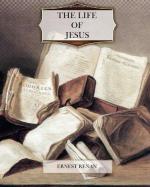in the twenty or thirty years which followed the death
of Jesus, and imposed upon his biography the peculiarities
of an ideal legend. Death adds perfection to
the most perfect man; it frees him from all defect
in the eyes of those who have loved him. With
the wish to paint the Master, there was also the desire
to explain him. Many anecdotes were conceived
to prove that in him the prophecies regarded as Messianic
had had their accomplishment. But this procedure,
of which we must not deny the importance, would not
suffice to explain everything. No Jewish work
of the time gives a series of prophecies exactly declaring
what the Messiah should accomplish. Many Messianic
allusions quoted by the evangelists are so subtle,
so indirect, that one cannot believe they all responded
to a generally admitted doctrine. Sometimes they
reasoned thus: “The Messiah ought to do
such a thing; now Jesus is the Messiah; therefore
Jesus has done such a thing.” At other
times, by an inverse process, it was said: “Such
a thing has happened to Jesus; now Jesus is the Messiah;
therefore such a thing was to happen to the Messiah."[1]
Too simple explanations are always false when analyzing
those profound creations of popular sentiment which
baffle all systems by their fullness and infinite
variety. It is scarcely necessary to say that,
with such documents, in order to present only what
is indisputable, we must limit ourselves to general
features. In almost all ancient histories, even
in those which are much less legendary than these,
details open up innumerable doubts. When we have
two accounts of the same fact, it is extremely rare
that the two accounts agree. Is not this a reason
for anticipating many difficulties when we have but
one? We may say that amongst the anecdotes, the
discourses, the celebrated sayings which have been
given us by the historians, there is not one strictly
authentic. Were there stenographers to fix these
fleeting words? Was there an analyst always present
to note the gestures, the manners, the sentiments
of the actors? Let any one endeavor to get at
the truth as to the way in which such or such contemporary
fact has happened; he will not succeed. Two accounts
of the same event given by different eye-witnesses
differ essentially. Must we, therefore, reject
all the coloring of the narratives, and limit ourselves
to the bare facts only? That would be to suppress
history. Certainly, I think that if we except
certain short and almost mnemonic axioms, none of the
discourses reported by Matthew are textual; even our
stenographic reports are scarcely so. I freely
admit that the admirable account of the Passion contains
many trifling inaccuracies. Would it, however,
be writing the history of Jesus to omit those sermons
which give to us in such a vivid manner the character
of his discourses, and to limit ourselves to saying,
with Josephus and Tacitus, “that he was put to
death by the order of Pilate at the instigation of
the priests”? That would be, in my opinion,
a kind of inexactitude worse than that to which we
are exposed in admitting the details supplied by the
texts. These details are not true to the letter,
but they are true with a superior truth, they are
more true than the naked truth, in the sense that
they are truth rendered expressive and articulate—truth
idealized.




